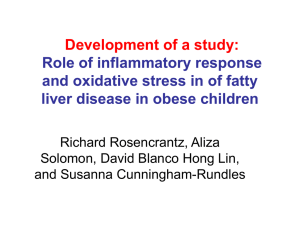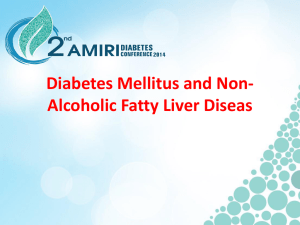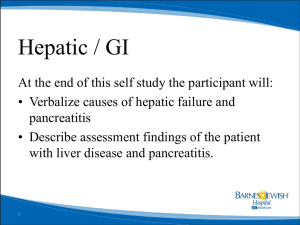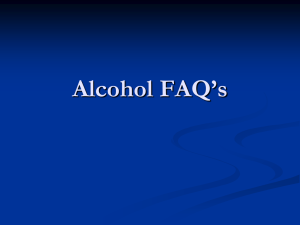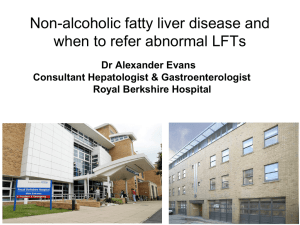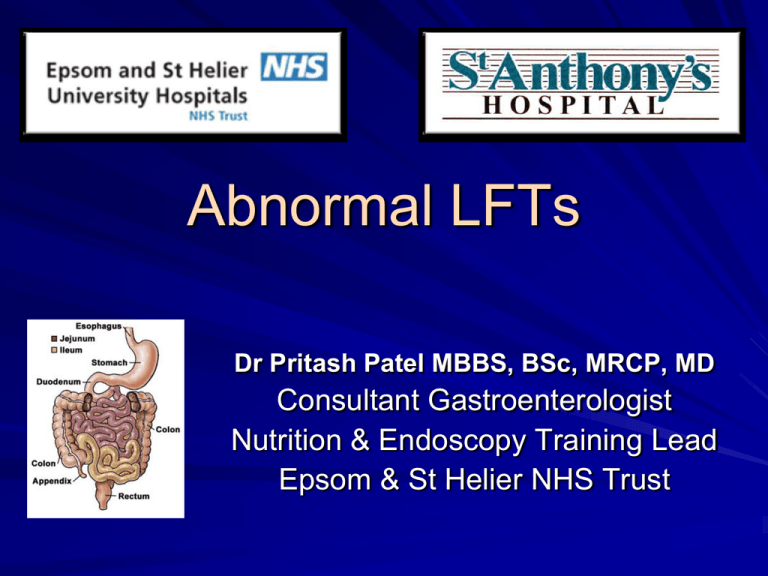
Abnormal LFTs
Dr Pritash Patel MBBS, BSc, MRCP, MD
Consultant Gastroenterologist
Nutrition & Endoscopy Training Lead
Epsom & St Helier NHS Trust
LFT’s
Markers of hepatocellular damage
Cholestasis
Liver synthetic function
Markers of Hepatocellular damage
(Transaminases)
AST- liver, heart skeletal muscle, kidneys, brain, RBCs
In liver 20% activity is cytosolic and 80% mitochondrial
Clearance performed by sinusoidal cells, half-life 17hrs
ALT – more specific to liver, v.low concentrations in
kidney and skeletal muscles
In liver totally cytosolic
Half-life 47hrs
Gamma-GT – hepatocytes and biliary epithelial
cells, pancreas, renal tubules and intestine
Very sensitive but Non-specific
Raised in ANY liver discease hepatocellular or
cholestatic
Usefulness limited
Confirm hepatic source for a raised ALP
Alcohol
Isolated increase does not require any further
evaluation, suggest watch and rpt 3/12 only if other
LFT’s become abnormal then investigate
Markers of Cholestasis
ALP – liver and bone (placenta, kidneys, intestines or
WCC)
Hepatic ALP present on surface of bile duct epithelia
and accumulating bile salts increase its release from cell
surface. Takes time for induction of enzyme levels so
may not be first enzyme to rise and half-life is 1 week.
ALP isoenzymes, 5-NT or gamma GT may be necessary
to evaluate the origin of ALP
Bilirubin, Albumin and Prothrombin time
(INR)
Useful indicators of liver synthetic
function
In primary care when associated with
liver disease abnormalities should raise
concern
Thrombocytopaenia is a sensitive
indicator of liver fibrosis/Splenomegaly
Patterns of liver enzyme alteration
Hepatic vs cholestatic
Magnitude of enzyme alteration (ALT >10x vs
minor abnormalities)
Rate of change
Nature of the course of the abnormality (mild
fluctuation vs progressive increase)
Patterns of liver enzyme alteration
Acute hepatitis –transaminase > 10x ULN
Cholestatic
Mild rise in ALT
Acute hepatitis (ALT>10xULN)
Limited Number of Causes
Viral
Ischaemic
Toxins/Drugs
Autoimmune
Early phase of acute obstruction
Acute hepatitis (ALT>10xULN)
Viral – Hep A, B, C, E, CMV, EBV
ALT levels usually peak before jaundice
appears.
Jaundice occurs in 70% Hep A, 35% acute Hep
B, 25% Hep C
Check for exposure
Check Hep A IgM, Hep B core IgM and
HepBsAg, Hep C IgG or Hep C RNA
Acute hepatitis (ALT>10xULN)
Ischaemic- sepsis, hypotension
?most common cause in-patients
Often extremely high >50x
Decrease rapidly
LDH raised 80%
Rarely jaundiced
Acute hepatitis (ALT>10xULN)
Toxins - paracetamol (up to 50% of all cases of
Acute Liver Failure)
Ecstasy ( 2nd most common cause in the young
<35)
Any drug
herbal remedies
Alcohol – almost never, AST <7xULN in 98%
AST/ALT ratio > 1 in 92%, >2 in 70%
Acute hepatitis (ALT>10xULN)
Autoimmune
Rarely presents with acute hepatitis
Usually jaundiced and progressive liver failure
Raised IgG and autoantibodies (anti-SM, -LKM, SLA)
Liver biopsy
Steroids and azathioprine
Acute hepatitis (ALT>10xULN)
Early phase- extrahepatic obstruction/cholangitis
Usually have history of pain
USS – dilated CBD ? ERCP or lap chole
Cholestasis
Isolated ALP 3rd trimester, adolescents
Bone – exclude by raised GGT, 5-NT or
isoenzymes
May suggest biliary obstruction, chronic liver
disease or hepatic mass/tumour
Liver USS/CT most important investigationdilated ducts
Ca pancreas, CBD stones, cholangio. or liver
mets
Cholestasis – non-dilated ducts
Cholestatic jaundice – Drugs- Antibiotics,
NSAIDs, Hormones, ACEI
PBC – anti- mitochondrial Ab, M2 fraction,
IgM
PSC – associated with IBD 70%, p-ANCA,
MRCP and liver biopsy
Chronic liver disease
Cholangiocarcinoma – beware fluctuating
levels
Primary or Metastatic cancer, lymphoma
Infiltrative – sarcoid, inflammatory-PMR, IBD
Liver biopsy often required
“Dear Dr Hepaticus,
I have just reviewed our patient data
base and have identified 420 patients
with persistently abnormal LFTs who
are otherwise well and are not known
to have liver disease. When can you
see them?
Yours,
Dr G Practice”
COMMON CAUSES OF
ABNORMAL LFTS IN THE UK
Transient mild abnormalities which
are simply impossible to explain
Drugs – eg Statins
Alcohol excess
Hepatitis C
Non-Alcoholic Fatty Liver Disease
(NAFLD)
Investigation of Abnormal LFTs
PRINCIPLES
2.5% of population have raised LFTs
Normal LFTs do not exclude liver disease
Interpret LFTs in clinical context
Take a careful history for risk factors, drugs (inc
OTCs), alcohol, comorbidity, autoimmunity
Physical examination for liver disease
Chase likely diagnosis rather than follow
algorithm unless there are no clues
If mild abnormalities and no risk factors or
suggestion of serious liver disease , repeat
LFTs after an interval (with lifestyle
modification)
Investigation of Abnormal LFTs ALT/AST 2-5x normal (100-200)
History and Examination
Discontinue hepatotoxic drugs
Continue statins but monitor LFTs
monthly
Lifestyle modification (lose wt, reduce
alcohol, diabetic control)
Repeat LFTs at 1 month and 6 months
Investigation of Abnormal LFTs
- Raised ALT / AST
If still abnormal at 6 months:
Consider referral to secondary care
Hepatitis serology (B, C)
Iron studies – transferrin saturation +
ferritin +/- HFE gene analysis
Autoantibodies & immunoglobulins
Consider caeruloplasmin
Alpha-1- antitrypsin
Coeliac serology
TFTs, lipids/glucose
Consider liver biopsy esp if ALT > 100)
Prevalence of Inherited Liver Diseases
H o m o z yg o te
F re q u e n c y
G ene
F re q u e n c y
H e te ro z yg o te
F re q u e n c y
H a e m o c h ro m a to s is 1 :4 0 0
1 :2 0
1 :1 0
α 1 A T D e fic ie n c y
1 :1 6 0 0
1 :4 0
1 :2 0
C y s tic F ib ro s is
1 :2 5 0 0
1 :5 0
1 :2 5
W ils o n 's D is e a s e
1 :3 0 ,0 0 0
1 :1 7 0
1 :8 5
D is e a s e
Leggett et al Brit J. Haem. 1990
Liver biopsy Findings in
Abnormal LFTs
Skelly et al:
354 Asymptomatic patients
Transaminases persistently 2X normal
No risk factors for liver disease
Alcohol intake < 21 units/week
Viral and autoimmune markers negative
Iron studies normal
Skelly et al. J Hepatol 2001; 35: 195-294
Liver biopsy Findings in Abnormal
LFTs Skelly et al. J Hepatol 2001
6% Normal
26% Fibrosis
6% Cirrhosis
34% NASH (11% of which had bridging
fibrosis and 8% cirrhosis)
32% Simple Fatty Liver
18% Alteration in Management
3 Families entered into screening
programmes
Other Liver biopsy Findings in
Abnormal LFTs Skelly et al. J Hepatol 2001
Cryptogenic hepatitis
Drug induced
Alcoholic liver disease
Autoimmune hepatitis
PBC
PSC
Granulomatous disease
1.75%
Haemochromatosis
Amyloid
Glycogen storage disease
9%
7.6%
2.8%
1.9%
1.4%
1.1%
1%
0.3%
0.31%
What is the Value of Liver Biopsy
in Abnormal LFTs?
The most accurate way to grade the severity of
liver disease
Aminotransferase levels correlate poorly with
histological activity
Narrows the diagnostic options, if not
diagnostic
LIVER BIOPSY FOR
SERONEGATIVE ALT < 2X
NORMAL
N = 249, mean age 58, Etoh < 25 units per
week, 9% diabetes, 24% BMI > 27
ALT 51-99 (over 6 m)
72% NAFLD
10% Normal histologically
Others: Granulomatous liver disease 4%,
Autoimmune 2.7%, cryptogenic hepatitis 2.5%,
ALD 1.4%, metobolic 2.1%, biliary 1.8%
Ryder et al BASL 2003
LIVER BIOPSY FOR
SERONEGATIVE ALT < 2X
NORMAL
Of those with NAFLD:
56% had simple steatosis
44% inflammation and/or fibrosis
Risk of Severe Fibrotic Disease associated with:
BMI >27
Gamma GT > 2x normal
Ryder et al BASL 2003
Ultrasound in Liver Disease
Detects Fatty Liver
Increased echogenicity may not be
specific for fat
Unable to detect Inflammation or
cirrhosis (unless advanced)
– Therefore unable to discriminate
between NASH and simple fatty liver or
identify other types of liver disease
(which may include fatty change)
Liver biopsy is the only way to make
an accurate diagnosis
It may be worth treating fatty liver for
6 months before considering referral
for biopsy
Other Imaging
CT
– Radiation
– Good for mass lesions
MRI/MRCP
– No radiation
– Good for obstructive pattern
ERCP
– Therapeutic
NASH, NAFLD,
the metabolic
syndrome and
statins
NAFLD is present in 17-33% of Americans
USS study showed fatty liver in 16% of lean 76% of obese
(in USA)
75% of type 2 DM have NAFLD
Worldwide distribution parallels the frequency of:
–
–
–
–
central adiposity,
insulin resistance,
metabolic syndrome
type 2 diabetes
NASH v NAFLD
NAFLD
NASH
10-25% of those with fatty liver (NAFLD) have
hepatocyte necrosis/ inflammation leading to evidence of
fibrosis (NASH)
Risk of progressive liver disease:
– NAFLD (any severity) 420 cases followed for 7 years (Olmsted
county, Minnesota) liver related mortality 1.7%
– 132 patients followed for 18 years, cirrhosis or liver related
death:
11% NAFLD stage 1-2 (fatty liver only)
25% NAFLD stage 3-4 (NASH with or without fibrosis)
– Overall: low risk, indolent course for most patients. Occasional
patient with rapidly progressive disease
– Highest risk is from cardiovascular disease
What about statins?
What should be monitored?
Alcohol intake?
Table 3. Relationship Between the Dose of Statin and the Incidence
of Persistent Elevation of ALT >3 Times ULN
Placebo
%
Lovastatin
Statin 10
mg %
0.1
Simvastatin
Pravastatin
1.3
Fluvastatin
0.28
Statin 20
mg %
Statin 40
mg %
Statin 80
mg %
0.1
0.9
2.3
0.7
0.9
2.1
1.4
0.2
1.5
2.7
2.3
Atorvastatin
0.2
0.2
0.6
Rosuvastatin
0
0
0.1
Overall effect of statins on ALT
meta-analysis of 49,275 patients who participated in 13 large, placebocontrolled trials of statins, therapy with statins at low-to-moderate doses
was not associated with a significant increase in liver enzyme elevations
compared to placebo (OR 1.26, 95% CI 0.99-1.62).
– We know statins often slightly elevate ALT
– Probably hyperlipidaemic patients have fluctuations in ALT (not on statins)
– Some statin treated patients may show improvement in ALT
What is the significance of raised
ALT on statins?
Raised ALT often improves on stopping or reducing dose
If dose is continued ALT usually stays stable or improves
slightly (exhibits “adaption”)
If you continue statin with raised ALT is this “damaging” liver?
– Is there a risk of acute liver failure?
Acute liver failure is very rare: of 51,741 US liver transplants (1990-2002)
1 caused by simvastatin and 2 by cerivastatin (no longer available)
Incidence of fulminant liver failure due to lovastatin is 2 in 1 million
– Is there a risk of progressive fibrosis to cirrhosis?
Probably not (difficulty separating NASH effect from statin effect)
Statin advice summary
No good evidence to withhold statins if pre-existing
abnormal LFTs
Manufacturers advise stopping statins if ALT raised x3 on
two occasions (0.4% of patients in 4S trial)
– Arbitrary cut off based on 4s trial design
– If very good indication for statins consider continuing
statins (+/- liver biopsy to look for NASH if apparent
progressive deterioration in LFTs over time)
“Causes” of nonalcoholic fatty liver
disease
Metabolic disorders
–
–
–
–
Diabetes mellitus
Obesity
Hyperlipidaemia
Starvation, kwashiorkor
Drugs
–
–
–
–
Chemotherapy agent, methotrexate
Amiodorone
Oestrogens and tamoxifen
Steroids
Diagnosing NAFLD
Raised ALT (0-4 fold)
Gamma GT often raised
33% have mildly raised ALP
USS and CT both sensitive (75-80%) at detecting
moderate/severe fatty infiltration (>33% of liver)
Risk factors for progressive
disease
Obesity, males, age (>45), diabetes, higher LFTs, presence of fibrosis
on initial biopsy
AST/ALT ratio:
– <1 useful to differentiate NAFLD from alcohol/ other causes of liver
disease
– >1 marker of fibrosis (advanced NASH)
Other fibrosis markers (ELF score, fibroscan)
Who to biopsy?
– Diagnostic uncertainty
– Stage disease
NASH/ NAFLD non-drug treatment
ANY ROUTE TO WEIGHT LOSS (not too fast):
– Evidence shows that slow weight loss improves ALT levels,
resolves steatohepatitis and reverses fibrosis in NASH
– Some evidence of good improvement in histology, reversal of
fibrosis after anti obesity surgery
– Aim for 10%
Can they drink? – one study suggested light to moderate
alcohol intake reduced liver steatosis in obese patients
prior to surgery. Therefore 21 units men, 14 units women
are allowed.
Drug treatments for NASH / NAFLD
Class of drug; agents
Type of Study
Effects
Comments/Adverse Effect
Metformin
Open-label, randomized trial (n
= 55) vs. vitamin E (n = 28) or
prescribed diet (n = 27) for 52
weeks
Improved ALT more often;
reduced metabolic
syndrome severity
Selected (n = 14) metformin-treated subjects
had improved steatosis, necroinflammatory
change and fibrosis
Pioglitazone
Open-label
Improved ALT and liver
histology
N = 18; loss of steatohepatitis; weight gain
average 4%
Randomized (open-label)
Improved ALT and liver
histology
N = 21; both groups improved, but greater
histological improvement in combination
group
Open-label
Improved ALT and liver
histology
N = 30; 10% withdrew, weight gain in 67%,
median 7.3% of body wt.; relapse
posttreatment
Vitamin E
Open-label
Improved ALT
Children, n = 11, treated 4-10 months; no
histology
Vitamin E
Open-label
Improved ALT
N = 22; no histology
Vitamin E + C
RCT - vs. placebo
Improved histology
N = 45, but only 9 biopsied posttreatment; AT
changes not mentioned
Betaine
RCT - vs. placebo
Improved ALT
N = 191, No histology
Betaine
Open-label
Improved ALT
N = 8; improved histology
Ursodeoxycholic acid
RCT - vs. placebo
ALT improved in both
groups (no difference)
N = 100, No difference between groups; no
histology
Insulin-sensitizing
Pioglitazone +
vitamin E
Rosiglitazone
Antioxidant / others
Orlistat
Open label study
Improved ALT and
histology
N=14. 6 months, biopsies before and after, steatosis better in
10/14; inflammation better in 7/14; fibrosis better in 3/14.
Pravastatin
Open label study
Improved ALT and
histology
N=5. All five normalised ALT after 6 months
atorvastatin
Open label study
Improved ALT and
liver histology
N=7. 21 months follow up, some improvement in histology
More recent studies:
68 patients on statin or not with NAFLD followed up with repeat liver biopsy,
significant improvement in liver steatosis on statins but not in those not on
statins (Hepatology 2007)
Long term follow up of UDCA and vitamin E in NASH (2011) – improved LFTs and histology
247 patients: Pioglitazone v vitamin E v placebo for NASH (NEJM 2010) – significant improvement
with Vitamin E 800IU a day on histology and liver function tests
SUMMARY
Treat metabolic syndrome as usual, if you need metformin, a
glitazone, a statin then these also will slightly help liver. Only
liver specific therapy appropriate at present is vitamin E +/UDCA but limited evidence.
NAFLD CONCLUSIONS
NAFLD is common
A small proportion progress to cirrhosis
NASH is the commonest cause of
cryptogenic cirrhosis
More information needed on prevalence,
pathogenesis and natural history
RCTs urgently needed - Metfomin,
antioxidants and UDCA
Case
LFTs- ALT 123 AFP 5
USS- normal
Genotype 3
Viral load >6 million IU/ml
Hepatitis B, HIV- Normal
Started on Peg interferon 180mcg/week and
ribavarin 1.2 g daily
Case
35 male unemployed
Diagnosed Hepatitis C from GUM clinicasymptomatic
Previous IVDU-now on methadone for 12
months
EtOH-30units/week
PMH-nil of note
DH-nil else
Case
3/12-viral load-undetectable
Pt experienced few side effects including
flu like symptoms, myalgia and low moodstarted on citalopram
Completed 24/52 of Rx successfully
Repeat viral load 6/12 after cessation of
Rx-still undetctable-deemed as sustained
viral response (SVR).
Hepatitis C
Hep C: Major problem in western world
– ½ million infected with the virus in UK- only
10% are diagnosed, even less are treated
–
–
–
–
–
15% spontaneously clear the virus
Transmitted through blood, sex
Initial test Hep C antibody
ALT, Hep C RNA, genotype
Genotype 1: need liver biopsy to assess inflammation
& fibrosis
– Non-genotype 1: treat without live bx
Hepatitis C
Usual treatment:
– NICE guidance
– Peg IF & ribavarin-48/52 for genotype 1 &
24/52 for non genotype 1
– SVR >85% in non genotype 1 % 40-50% in
type 1. Cirrhotics SVR 15-20%
– IVDU now being treated more & more
Liver disease updates
Viral hepatitis
– Hepatitis B
Long term entacavir or tenofovir monotherapy
– Few side effects, excellent clinical response but very few
cases become HbsAG negative
– Hepatitis C
Ribavirin and pegalated interferon
New drugs: boceprevir, telaprovir to be NICE
approved for genotype 1 in 2012
Hope for >90% cure rate (except genotype 4)
Abnormal LFTs - Conclusions
Many abnormal LFTs will return to
normal spontaneously
An important minority of patients with
abnormal LFTs will have important
diagnoses, including communicable and
potentially life threatening diseases
Investigation requires clinical
assessment and should be timely and
pragmatic
Questions
NHS
Epsom Hospital
Private
The Clockhouse
– Clinics Mon pm, Weds
am
– Endoscopy Thurs pm
St Helier Hospital
– Endoscopy Weds pm,
Fri pm
– Fri am
Ashtead
– Mon eve
– Choose and Book
St. Anthony’s
– Thurs
pritash.patel@esth.nhs.uk
01372735129




